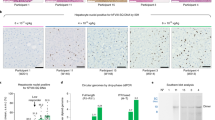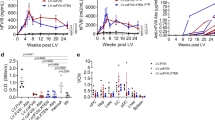Abstract
We previously demonstrated that direct intramuscular injection of recombinant adeno-associated virus (rAAV) carrying the human FIX (hFIX) cDNA can safely be administered to hemophilic B canines and express human factor IX protein; however, the functional activity of the hFIX protein could not be assessed due to anti-human FIX antibody (inhibitor) formation. To test the therapeutic efficacy of rAAV in hemophilic dogs, rAAV type 2 (rAAV2) carrying canine FIX (cFIX) cDNA was injected into the skeletal muscle of two dogs at doses of 1012–13particles. Circulating cFIX protein levels were maintained for 1 year at levels of 1–2% of normal. Hemostatic correction (WBCT and APTT) paralleled plasma FIX antigen levels. Both dogs still required plasma infusion for spontaneous and traumatic bleeding events. Inhibitors to cFIX protein were not detected in either animal by Bethesda assay. Neutralizing antibodies directed against AAV-2 capsid were pronounced and persistent. Vector DNA and mRNA transcripts were detected only at the injected skeletal muscle tissue. Analysis of both high and low molecular weight DNA identified both replicative episomal and integrated AAV species. These results demonstrate that persistent secretion of the FIX transgene protein, necessary for successful gene therapy of hemophilia B, can be achieved using the parvovirus-based rAAV vector
This is a preview of subscription content, access via your institution
Access options
Subscribe to this journal
Receive 12 print issues and online access
$259.00 per year
only $21.58 per issue
Buy this article
- Purchase on Springer Link
- Instant access to full article PDF
Prices may be subject to local taxes which are calculated during checkout







Similar content being viewed by others
References
Lusher J . Transfusion therapy in congenital coagulopathies Hematol Oncol Clin N Am 1994 8: 1167–1180
Brinkhous K et al. Recombinant human factor IX: replacement therapy, prophylaxis, and pharmacokinetics in canine hemophilia B Blood 1996 88: 2603–2610
Soucie J et al. Hepatitis A virus infections associated with clotting factor concentrate in the United States Transfusion 1998 38: 573–579
National Hemophilia Foundation. The treatment of hemophilia and related bleeding disorders, Medical Advisory No. 312. In: Medical and Scientific Advisory Council (MASAC) Recommendations. New York 1998 p 11–34
Lofqvist T, Nilsson I, Berntorp E, Pettersson H . Haemophilia prophylaxis in young patients – a long-term follow-up J Intern Med 1997 241: 395–400
Petrini P, Lindvall N, Egberg N, Blomback M . Prophylaxis with factor concentrates in preventing hemophilic arthropathy Am J Pediat Hematol Oncol 1991 13: 280–287
Kay M et al. In vivo gene therapy of hemophilia B: sustained partial correction in factor IX-deficient Science 1993 262: 117–119
Dai Y et al. Cellular and humoral immune responses to adenoviral vectors containing factor IX gene: tolerization of factor IX and vector antigens allows for long-term expression Proc Nat Acad Sci USA 1995 92: 1401–1405
Rabinowitz J, Samulski J . Adeno-associated virus expression system for gene transfer Curr Opin Biotechnol 1998 9: 470–475
Berns K, Bohenzky R . Adeno-associated viruses: an update Adv Virus Res 1987 32: 243–306
Afione S et al. In vivo model of adeno-associated virus vector persistence and rescue J Virol 1996 70: 3235–3241
Flotte T et al. Stable in vivo expression of the cystic fibrosis transmembrane conductance regulator with an adeno-associated virus vector Proc Natl Acad Sci USA 1993 90: 10613–10617
Xiao X, Li J, Samulski R . Efficient long-term gene transfer into muscle tissue of immunocompetent mice by adeno-associated virus vector J Virol 1996 70: 8098–8108
Flotte T, Carter B . Adeno-associated virus vectors for gene therapy Gene Therapy 1995 2: 357–362
Dong J, Fan P, Frizzell R . Quantitative analysis of the packaging capacity of recombinant adeno-associated virus Hum Gene Ther 1996 7: 2101–2112
Clark K, Sferra T, Johnson P . Recombinant adeno-associated viral vectors mediate long-term transgene expression in muscle Hum Gene Ther 1997 8: 659–669
Yao S, Kurachi K . Expression of human factor IX in mice after injection of genetically modified myoblasts Proc Natl Acad Sci USA 1992 89: 3357–3361
Herzog R et al. Stable gene transfer and expression of human blood coagulation factor IX after intramuscular injection of recombinant adeno-associated virus Proc Nat Acad Sci USA 1997 94: 5804–5809
Evans J et al. Canine hemophilia B resulting from a point mutation with unusual consequences Proc Nat Acad Sci USA 1989 86: 10095–10099
Liles D et al. Extravascular administration of factor IX: potential for replacement therapy of canine and human hemophilia B Thromb Haemostas 1997 77: 944–948
Monahan P et al. Direct intramuscular injection with recombinant AAV vectors results in sustained expression in a dog model of hemophilia Gene Therapy 1998 5: 40–49
Kurachi S, Hitomi Y, Furukawa M, Kurachi K . Role of intron I in expression of the human factor IX gene J Biol Chem 1995 270: 5276–5281
Xiao X, Li J, Samulski R . Production of high-titer recombinant adeno-associated virus vectors in the absence of helper adenovirus J Virol 1998 72: 2224–2232
Evans J et al. Molecular cloning of a cDNA encoding canine factor IX Blood 1989 74: 207–212
Anderson L . Human parvoviruses J Infect Dis 1990 161: 603–608
Ferrari F, Samulski T, Shenk T, Samulski R . Second-strand synthesis is a rate-limiting step for efficient transduction by recombinant adeno-associated virus vectors J Virol 1996 70: 3227–3234
Flannery J et al. Efficient photoreceptor-targeted gene expression in vivo by recombinant adeno-associated virus Proc Natl Acad Sci USA 1997 94: 6916–6921
Nilsson I, Berntorp E, Lofqvist T, Pettersson H . Twenty-five years’ experience of prophylactic treatment in severe haemophilia A and B J Intern Med 1992 232: 25
Herzog R et al. Long-term correction of canine hemophilia B by gene transfer of blood coagulation factor IX mediated by adeno-associated viral vector Nature Med 1999 5: 56–63
Snyder R et al. Correction of hemophilia B in canine and murine models using recombinant adeno-associated viral vectors Nature Med 1999 5: 64–70
Snyder R et al. Persistent and therapeutic concentrations of human factor IX in mice after hepatic gene transfer of recombinant AAV vectors Nat Genet 1997 16: 270–276
Summerford C, Samulski R . Membrane-associated heparan sulfate proteoglycan is a receptor for adeno-associated virus type 2 virions J Virol 1998 72: 1438–1445
Summerford C, Bartlett J, Samulski R . AlphaVbeta5 integrin: a co-receptor for adeno-associated virus type 2 infection Nature Med 1999 5: 78–82
Qing K et al. Human fibroblast growth factor receptor 1 is a co-receptor for infection by adeno-associated virus 2 Nature Med 1999 5: 71–77
Summerford C, Samulski R . Viral receptors and vector purification: new approaches for generating clinical-grade reagents Nature Med 1999 5: 587
Chiorini J et al. Cloning of adeno-associated virus type 4 (AAV4) and generation of recombinant AAV4 particles J Virol 1997 71: 6823–6833
Kessler P et al. Gene delivery to skeletal muscle results in sustained expression and systemic delivery of a therapeutic protein Proc Natl Acad Sci USA 1996 93: 14082–14087
Fisher K et al. Recombinant adeno-associated virus for muscle directed gene therapy Nature Med 1997 3: 306–312
Fisher K et al. Transduction with recombinant adeno-associated virus for gene therapy is limited by leading-strand synthesis J Virol 1996 70: 520–532
Duan D et al. Circular intermediates of recombinant adeno-associated virus have defined structural characteristics responsible for long-term persistence in muscle tissue J Virol 1998 72: 8568–8577
Ni T et al. Cellular proteins required for adeno-associated virus DNA replication in the absence of adenovirus coinfection J Virol 1998 72: 2777–2787
Vincent-Lacaze N et al. Structure of adeno-associated virus vector DNA following transduction of the skeletal muscle J Virol 1999 73: 1949–1955
Wolberg A, Stafford D, Erie D . Human factor IX binds to specific sites on the collagenous domain of collagen IV J Biol Chem 1997 272: 16717–16720
Roberts H, Eberst M . Current management of hemophilia B Hematol Oncol Clin N Am 1993 7: 1269–1280
Greelish J et al. Stable restoration of the sarcoglycan complex in dystrophic muscle perfused with histamine and a recombinant adeno-associated viral vector Nature Med 1999 5: 439
Ferrari F, Xiao X, McCarty D, Samulski R . New developments in the generation of Ad-free, high-titer rAAV gene therapy vectors Nature Med 1997 3: 1295–1297
Hirt B . Selective extraction of polyoma DNA from infected mouse cell cultures J Mol Biol 1967 26: 365–369
Sambrook J, Fritsch E, Maniatis T . In: Nolan C. Molecular Cloning – a Laboratory Manual Cold Spring Harbor Laboratory Press: Cold Spring Harbor 1989 pp 6.20–21
Kingston R . Analysis of RNA by Northern and slot blot hybridization In: Ausubel F et al (eds) . Current Protocols in Molecular Biology John Wiley & Sons 1997 pp 4.9.1–4.9.13
Acknowledgements
We would like to thank Dr Robert Bagnell for his technical assistance, Ms Pam McElveen, Dan Ewell and the staff at the Francis Owen Blood Research Laboratory for their excellent care and handling of the animals, and the UNC Vector Core for helpful discussions. PEM is a Judith Graham Pool Fellow of the National Hemophilia Foundation. CEW is a recipient of the Lucille B Markey Charitable Trust.
Author information
Authors and Affiliations
Rights and permissions
About this article
Cite this article
Chao, H., Samulski, R., Bellinger, D. et al. Persistent expression of canine factor IX in hemophilia B canines. Gene Ther 6, 1695–1704 (1999). https://doi.org/10.1038/sj.gt.3301024
Received:
Accepted:
Published:
Issue Date:
DOI: https://doi.org/10.1038/sj.gt.3301024
Keywords
This article is cited by
-
Gene Therapy for Hemophilia: Progress to Date
BioDrugs (2018)
-
Prediction of adeno-associated virus neutralizing antibody activity for clinical application
Gene Therapy (2015)
-
Induction of Immune Tolerance to FIX Following Muscular AAV Gene Transfer Is AAV-dose/FIX-level Dependent
Molecular Therapy (2009)
-
Transgene expression levels and kinetics determine risk of humoral immune response modeled in factor IX knockout and missense mutant mice
Gene Therapy (2007)
-
Intrathecal Long-Term Gene Expression by Self-Complementary Adeno-Associated Virus type 1 Suitable for Chronic Pain Studies in Rats
Molecular Pain (2006)



